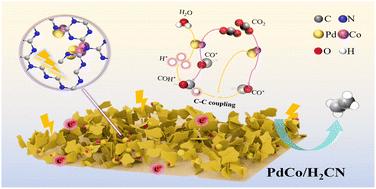富氮空位C3N4负载型PdCo催化剂选择性光催化CO2还原为C2H4
IF 9.5
2区 材料科学
Q1 CHEMISTRY, PHYSICAL
引用次数: 0
摘要
光催化CO2还原为高价值碳氢化合物已成为能源转换领域的一项前沿技术。为了解决多碳合成中光生电子密度不足和C-C耦合动力学缓慢的问题,通过二次氢辅助剥离方法在C3N4中精确设计了双氮空位(N2C/N3C)。这导致π共轭体系在缺陷位置的局域电子密度积累,产生强大的内置电场,实现高效的空间电荷分离。同时,PdCo合金改性克服了多碳偶联反应的局限性:Co优化了C1中间体(Co */CHO*)的吸附和稳定,而Pd通过促进氢化作用成为C-C偶联的活性中心。优化后的体系C2H4产率为36.3 μmol g−1 h−1,电子选择性为81.5%。这项工作为设计先进的CO2光还原系统建立了一个新的范例。本文章由计算机程序翻译,如有差异,请以英文原文为准。

Nitrogen vacancies rich C3N4 supported PdCo catalyst for selective photocatalytic CO2 reduction to C2H4
Photocatalytic CO2 reduction to high-value hydrocarbons has emerged as a cutting-edge technology in energy conversion. To address the challenges of insufficient photogenerated electron density and sluggish C–C coupling kinetics in multi-carbon synthesis, dual nitrogen vacancies (N2C/N3C) were precisely engineered in C3N4 through a secondary hydrogen-assisted exfoliation approach. This induces localized electron density accumulation of the π-conjugated system at defect sites, generating a robust built-in electric field that achieves highly efficient spatial charge separation. Meanwhile, the modification with PdCo alloys overcomes the limitations in multi-carbon coupling reactions: Co optimizes the adsorption and stabilization of C1 intermediates (CO*/CHO*), while Pd acts as the active centre for C–C coupling by facilitating hydrogenation. The optimized system achieves an exceptional C2H4 production rate of 36.3 μmol g−1 h−1 with 81.5% electron selectivity. This work establishes a new paradigm for designing advanced CO2 photoreduction systems.
求助全文
通过发布文献求助,成功后即可免费获取论文全文。
去求助
来源期刊

Journal of Materials Chemistry A
CHEMISTRY, PHYSICAL-ENERGY & FUELS
CiteScore
19.50
自引率
5.00%
发文量
1892
审稿时长
1.5 months
期刊介绍:
The Journal of Materials Chemistry A, B & C covers a wide range of high-quality studies in the field of materials chemistry, with each section focusing on specific applications of the materials studied. Journal of Materials Chemistry A emphasizes applications in energy and sustainability, including topics such as artificial photosynthesis, batteries, and fuel cells. Journal of Materials Chemistry B focuses on applications in biology and medicine, while Journal of Materials Chemistry C covers applications in optical, magnetic, and electronic devices. Example topic areas within the scope of Journal of Materials Chemistry A include catalysis, green/sustainable materials, sensors, and water treatment, among others.
 求助内容:
求助内容: 应助结果提醒方式:
应助结果提醒方式:


